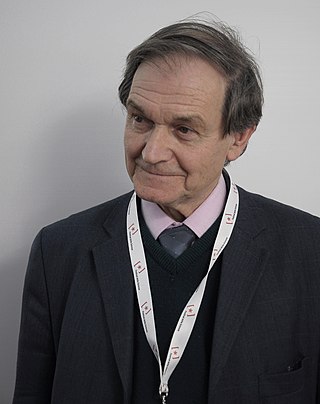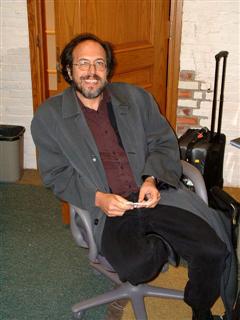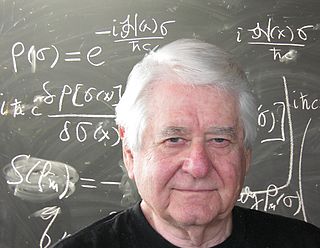
General relativity, also known as the general theory of relativity and Einstein's theory of gravity, is the geometric theory of gravitation published by Albert Einstein in 1915 and is the current description of gravitation in modern physics. General relativity generalises special relativity and refines Newton's law of universal gravitation, providing a unified description of gravity as a geometric property of space and time or four-dimensional spacetime. In particular, the curvature of spacetime is directly related to the energy and momentum of whatever matter and radiation are present. The relation is specified by the Einstein field equations, a system of second order partial differential equations.

Sir Roger Penrose is a British mathematician, mathematical physicist, philosopher of science and Nobel Laureate in Physics. He is Emeritus Rouse Ball Professor of Mathematics in the University of Oxford, an emeritus fellow of Wadham College, Oxford, and an honorary fellow of St John's College, Cambridge, and University College London.

In cosmology, the cosmological constant, alternatively called Einstein's cosmological constant, is the constant coefficient of a term that Albert Einstein temporarily added to his field equations of general relativity. He later removed it. Much later it was revived and reinterpreted as the energy density of space, or vacuum energy, that arises in quantum mechanics. It is closely associated with the concept of dark energy.

The Large Scale Structure of Space–Time is a 1973 treatise on the theoretical physics of spacetime by the physicist Stephen Hawking and the mathematician George Ellis. It is intended for specialists in general relativity rather than newcomers.

Lev Davidovich Landau was a Soviet physicist who made fundamental contributions to many areas of theoretical physics.

Lee Smolin is an American theoretical physicist, a faculty member at the Perimeter Institute for Theoretical Physics, an adjunct professor of physics at the University of Waterloo and a member of the graduate faculty of the philosophy department at the University of Toronto. Smolin's 2006 book The Trouble with Physics criticized string theory as a viable scientific theory. He has made contributions to quantum gravity theory, in particular the approach known as loop quantum gravity. He advocates that the two primary approaches to quantum gravity, loop quantum gravity and string theory, can be reconciled as different aspects of the same underlying theory. He also advocates an alternative view on space and time that he calls temporal naturalism. His research interests also include cosmology, elementary particle theory, the foundations of quantum mechanics, and theoretical biology.
Abhay Vasant Ashtekar is an Indian theoretical physicist who created Ashtekar variables and is one of the founders of loop quantum gravity and its subfield loop quantum cosmology. Ashtekar has also written a number of descriptions of loop quantum gravity that are accessible to non-physicists. He is an Evan Pugh Professor Emeritus of Physics and former Director of the Institute for Gravitational Physics and Geometry at Pennsylvania State University.

The Big Crunch is a hypothetical scenario for the ultimate fate of the universe, in which the expansion of the universe eventually reverses and the universe recollapses, ultimately causing the cosmic scale factor to reach zero, an event potentially followed by a reformation of the universe starting with another Big Bang. The vast majority of evidence indicates that this hypothesis is not correct. Instead, astronomical observations show that the expansion of the universe is accelerating rather than being slowed by gravity, suggesting that the universe is far more likely to end in heat death. However, there are new theories that suggest that a "Big Crunch-style" event could happen by the way of a Dark energy fluctuation, however this is still being debated amongst scientists.
The Big Bounce hypothesis is a cosmological model for the origin of the known universe. It was originally suggested as a phase of the cyclic model or oscillatory universe interpretation of the Big Bang, where the first cosmological event was the result of the collapse of a previous universe. It receded from serious consideration in the early 1980s after inflation theory emerged as a solution to the horizon problem, which had arisen from advances in observations revealing the large-scale structure of the universe.
Eva Silverstein is an American theoretical physicist, cosmologist, and string theorist. She is a professor of physics at Stanford University and director of the Modern Inflationary Cosmology collaboration within the Simons Foundation Origins of the Universe initiative.

Alexander Alexandrovich Friedmann was a Russian and Soviet physicist and mathematician. He originated the pioneering theory that the universe is expanding, governed by a set of equations he developed known as the Friedmann equations.

John W. Moffat is a Canadian physicist. He is currently professor emeritus of physics at the University of Toronto and is also an adjunct professor of physics at the University of Waterloo and a resident affiliate member of the Perimeter Institute for Theoretical Physics.

Isaak Markovich Khalatnikov was a leading Soviet theoretical physicist who made significant contributions to many areas of theoretical physics, including general relativity, quantum field theory, as well as the theory of quantum liquids. He is well known for his role in developing the Landau-Khalatnikov theory of superfluidity and the so-called BKL conjecture in the general theory of relativity.

Charles W. Misner was an American physicist and one of the authors of Gravitation. His specialties included general relativity and cosmology. His work has also provided early foundations for studies of quantum gravity and numerical relativity.
Robert Geroch is an American theoretical physicist and professor at the University of Chicago. He has worked prominently on general relativity and mathematical physics and has promoted the use of category theory in mathematics and physics. He was the Ph.D. supervisor for Abhay Ashtekar, Basilis Xanthopoulos and Gary Horowitz. He also proved an important theorem in spin geometry.
Hořava–Lifshitz gravity is a theory of quantum gravity proposed by Petr Hořava in 2009. It solves the problem of different concepts of time in quantum field theory and general relativity by treating the quantum concept as the more fundamental so that space and time are not equivalent (anisotropic) at high energy level. The relativistic concept of time with its Lorentz invariance emerges at large distances. The theory relies on the theory of foliations to produce its causal structure. It is related to topologically massive gravity and the Cotton tensor. It is a possible UV completion of general relativity. Also, the speed of light goes to infinity at high energies. The novelty of this approach, compared to previous approaches to quantum gravity such as Loop quantum gravity, is that it uses concepts from condensed matter physics such as quantum critical phenomena. Hořava's initial formulation was found to have side-effects such as predicting very different results for a spherical Sun compared to a slightly non-spherical Sun, so others have modified the theory. Inconsistencies remain, though progress was made on the theory. Nevertheless, observations of gravitational waves emitted by the neutron-star merger GW170817 contravene predictions made by this model of gravity. Some have revised the theory to account for this.
Anzhong Wang is a theoretical physicist, specialized in gravitation, cosmology and astroparticle physics. He holds a position on the Physics faculty of Baylor University. Currently he is working on cosmology in string/M theory and the Hořava–Lifshitz gravity.
Erin Rioux is an electronic psychedelic record producer, vocalist, and curator based in Brooklyn who makes music under the stage name Rioux. His work merges technology with traditional instrumentation, particularly guitar and bass guitar, to create a rhythmic yet cerebral sonic environment.
The SLAC Theory Group is the hub of theoretical particle physics research at the SLAC National Accelerator Laboratory at Stanford University. It is a subdivision of the Elementary Particle Physics (EPP) Division at SLAC.










